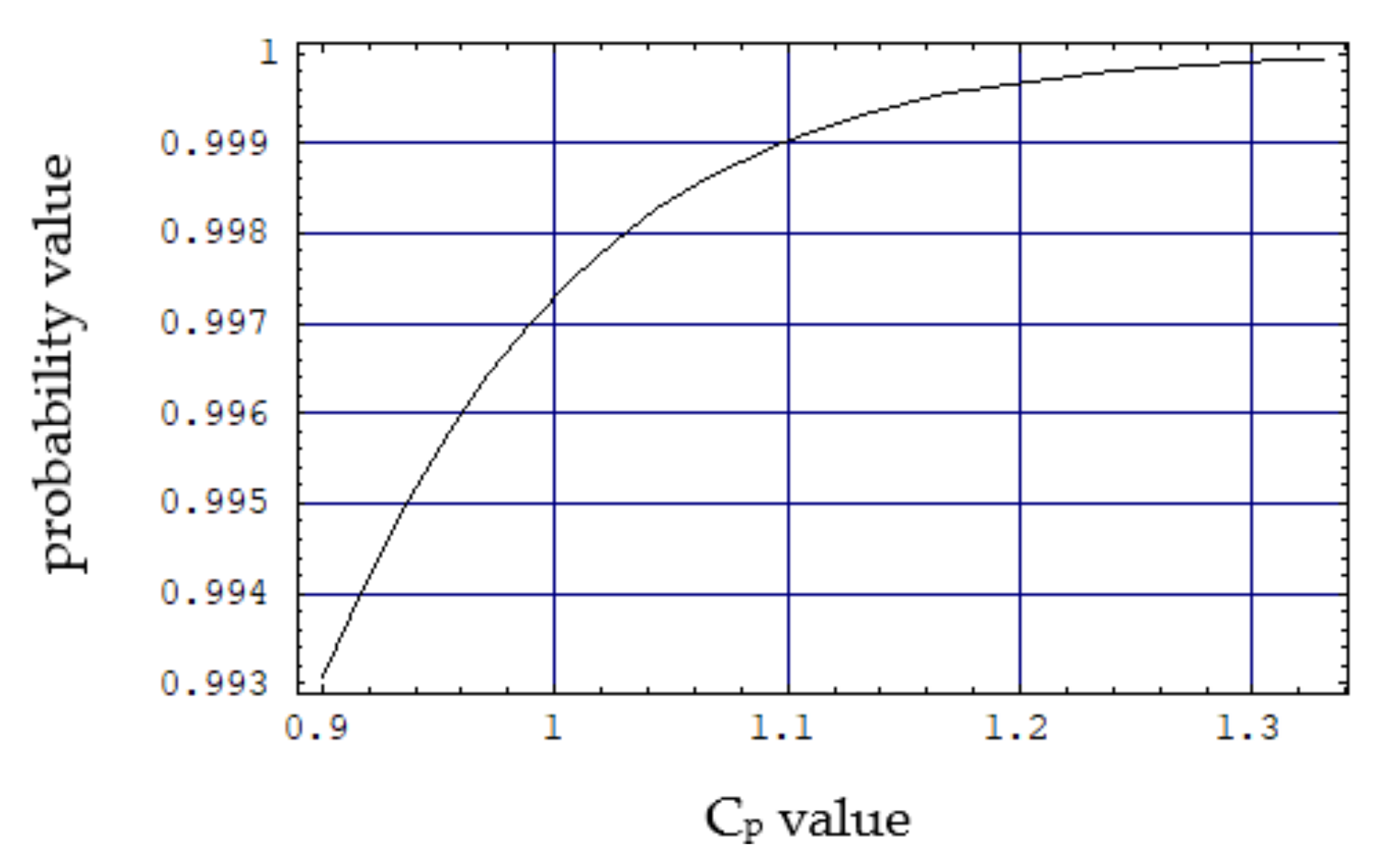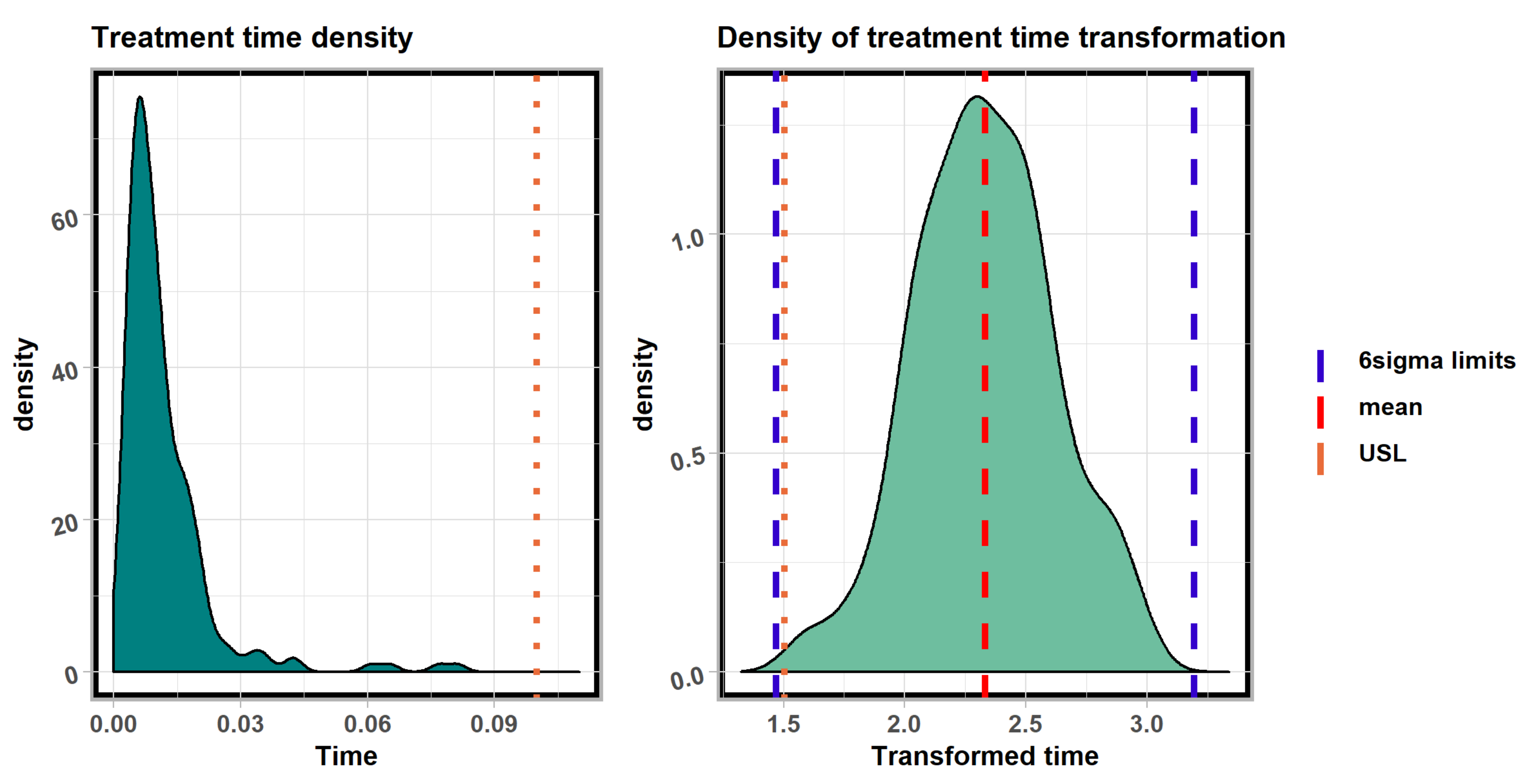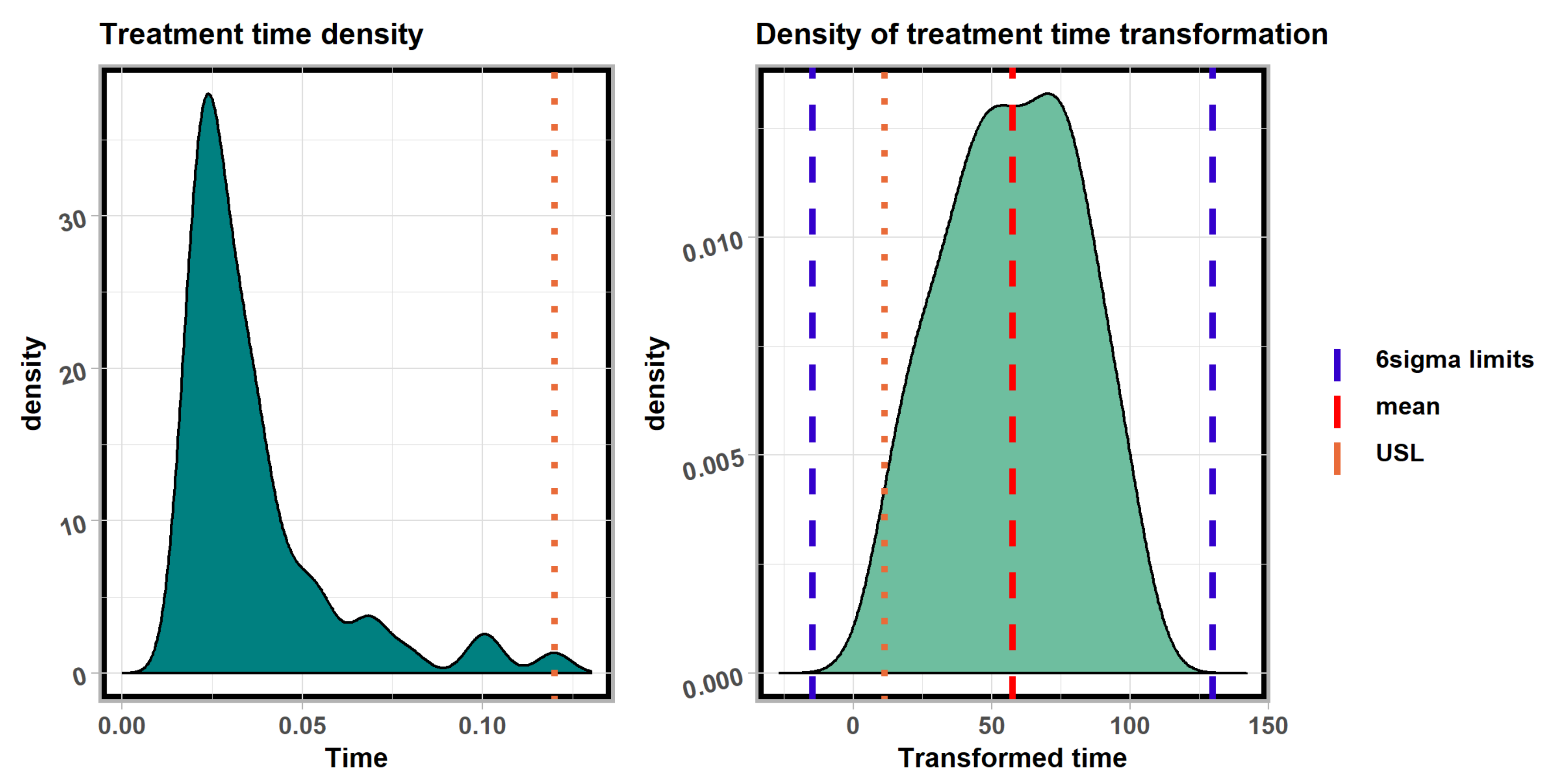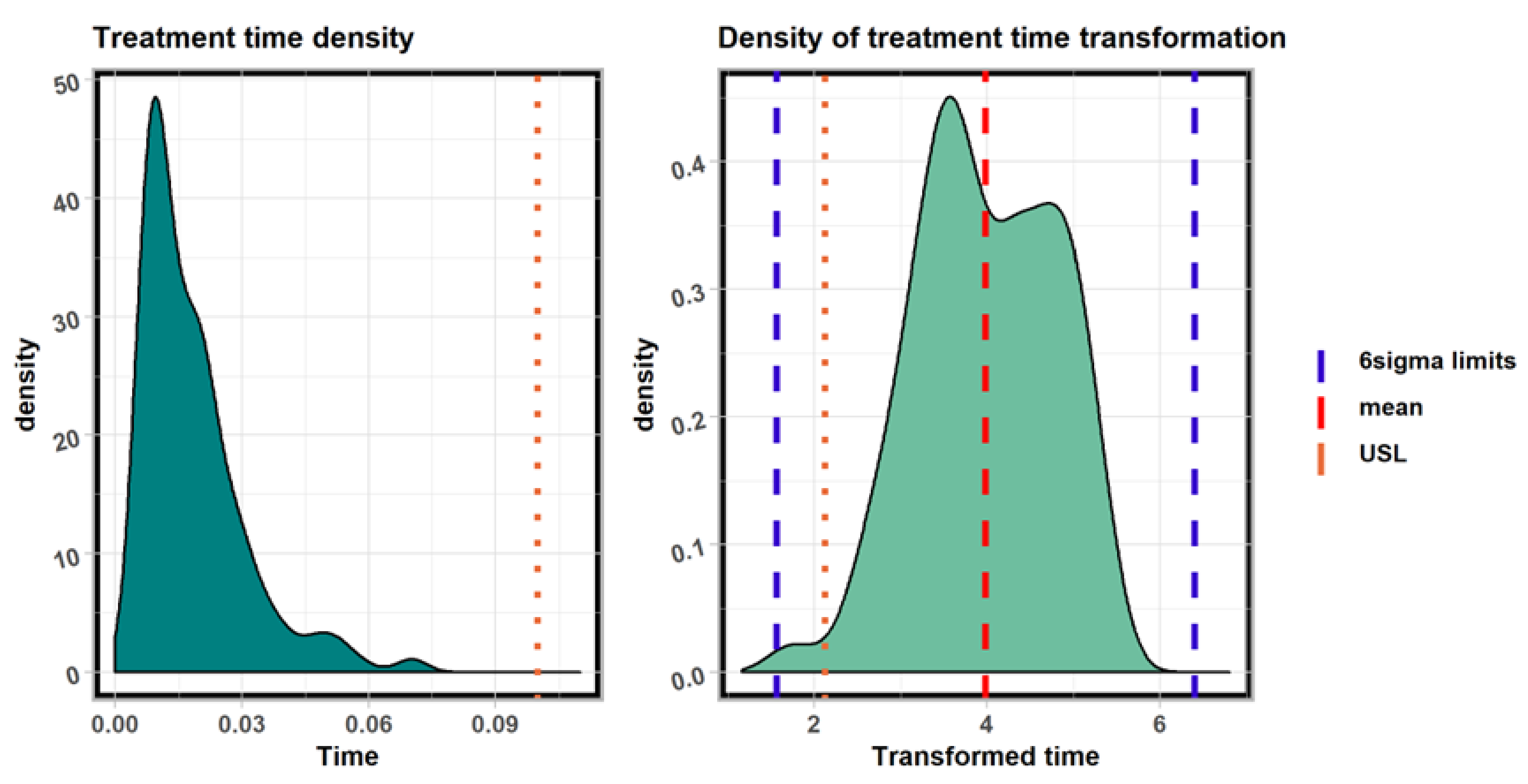A New Approach to Production Process Capability Assessment for Non-Normal Data
Abstract
1. Introduction
2. Indicators for Assessing the Quality Capability of the Process
3. Problem Formulation
4. Statistical Background of the Study
4.1. Box-Cox Transformation
4.2. Normality Test
4.3. Quality Capability Indicators for Unilateral Specification Limit
- 1.
- Determination of the mean value from the collected sample and standard deviation .
- 2.
- Calculation and determination of the absolute value from (14) or (15) depending on whether the specification limit is specified as LSL or USL.
- 3.
- Determine the probability of obtaining of goods products
- 4.
- Read the Cp value from the graph (Figure 1) corresponding to the determined probability value.
- 5.
- The Cpk value should be determined from Equation (2) depending on whether the specification limit is specified as LSL or USL. The value of this indicator should be referred to the value in Table 1.
5. Proposed Solution for Non-Normal Data
6. Research Results
6.1. Scope of Analysis
6.2. Distribution Normality Analysis and Transformation for Machine 1
6.3. Distribution Normality Analysis and Transformation for Machine 2
6.4. Normality Analysis and Transformation for Machine 3
6.5. Process Quality Capability Analysis
7. Conclusions
Author Contributions
Funding
Institutional Review Board Statement
Informed Consent Statement
Data Availability Statement
Conflicts of Interest
References
- Rogalewicz, M.; Kujawińska, A.; Feledziak, A. Ensuring the reliability and reduction of quality control costs by minimizing process variability. Eksploat. Niezawodn.—Maint. Reliab. 2023, 25, 162626. [Google Scholar] [CrossRef]
- Ahmed, A.; Page, J.; Olsen, J. Enhancing Six Sigma methodology using simulation techniques: Literature review and implications for future research. Int. J. Lean Six Sigma 2020, 11, 211–232. [Google Scholar] [CrossRef]
- Gijo, E.V.; Antony, J.; Sunder, M.V. Application of Lean Six Sigma in IT support services—A case study. TQM J. 2019, 31, 417–435. [Google Scholar]
- Martinez, F. Process excellence the key for digitalisation. Bus. Process Manag. J. 2019, 25, 1716–1733. [Google Scholar] [CrossRef]
- Yanamandra, R.; Alzoubi, H.M. Empirical investigation of mediating role of six sigma approach in rationalizing the COQ in service organizations. Oper. Supply Chain. Manag. Int. J. 2022, 15, 122–135. [Google Scholar]
- Narula, V.; Grover, S. Six Sigma-Literature Review And Implications For Future Research 2019. Int. J. Ind. Eng. Prod. Res. 2015, 26, 13–26. [Google Scholar]
- Anthony, S.G.; Antony, J. The History of Lean Six Sigma. In Lean Six Sigma in Higher Education Institutions; Emerald Publishing Limited: Bingley, UK, 2022; pp. 15–21. [Google Scholar]
- Excellence, M.B. Viewpoint: Six sigma implementation. In Measuring Business Excellence; Emerald Group Publishing Limited: Bingley, UK, 2003; Volume 7. [Google Scholar] [CrossRef]
- Brun, A. Critical success factors of Six Sigma implementations in Italian companies. Int. J. Prod. Econ. 2011, 131, 158–164. [Google Scholar] [CrossRef]
- Mathew, J.; Kurudkar, P.; Singh, S.; Singh, K.; Singh, B.; Mahajan, S. Quality and productivity improvement using Six Sigma—A literature review. Int. J. Innov. Eng. Sci. 2017, 2, 15–23. [Google Scholar]
- Antony, J.; Forthun, S.C.; Trakulsunti, Y.; Farrington, T.; McFarlane, J.; Brennan, A.; Dempsey, M. An exploratory study into the use of Lean Six Sigma to reduce medication errors in the Norwegian public healthcare context. Leadersh. Health Serv. 2017, 32, 509–524. [Google Scholar] [CrossRef]
- Trakulsunti, Y.; Antony, J.; Dempsey, M.; Brennan, A. Reducing medication errors using lean six sigma methodology in a Thai hospital: An action research study. Int. J. Qual. Reliab. Manag. 2012, 38, 339–362. [Google Scholar] [CrossRef]
- Niñerola, A.; Sánchez-Rebull, M.V.; Hernández-Lara, A.B. Quality improvement in healthcare: Six Sigma systematic review. Health Policy 2020, 124, 438–445. [Google Scholar] [CrossRef] [PubMed]
- Pyzdek, T.; Keller, P.A. The Six Sigma Handbook: A Complete Guide for Green Belts, Black Belts, and Managers at All Levels; McGraw Hill Professional: New York City, NY, USA, 2014. [Google Scholar]
- Samanta, A.K.; Gurumurthy, A. Implementing lean six sigma in health care: A review of case studies. Int. J. Lean Six Sigma 2023, 14, 158–189. [Google Scholar] [CrossRef]
- Ahmed, S. Integrating DMAIC approach of Lean Six Sigma and theory of constraints toward quality improvement in healthcare. Rev. Environ. Health 2019, 34, 427–434. [Google Scholar] [CrossRef] [PubMed]
- Cudney, E.A.; Venuthurumilli, S.S.J.; Materla, T.; Antony, J. Systematic review of Lean and Six Sigma approaches in higher education. Total Qual. Manag. Bus. Excell. 2020, 31, 231–244. [Google Scholar] [CrossRef]
- Gupta, S.; Arora, A. Six Sigma in financial services. Int. J. Adv. Res. Comput. Sci. Softw. Eng. 2012, 2, 76–80. [Google Scholar]
- Madhani, P.M. Lean six sigma deployment in finance and financial services: Enhancing competitive advantages. IUP J. Oper. Manag. 2020, 19, 25–49. [Google Scholar]
- Madhani, P.M. Lean Six Sigma in finance and accounting services for enhancing business performance. IJSSMET 2020, 12, 141–165. [Google Scholar] [CrossRef]
- Čaušević, S.; Avdagić-Golub, E. The challenges and opportunities of introducing six sigma at customer support telecommunication company. TEM J. 2019, 8, 1307. [Google Scholar]
- CR, A.; Thakkar, J.J. Application of Six Sigma DMAIC methodology to reduce the defects in a telecommunication cabinet door manufacturing process: A case study. Int. J. Qual. Reliab. Manag. 2019, 36, 1540–1555. [Google Scholar]
- Tay, H.L.; Aw, H.S. Improving logistics supplier selection process using lean six sigma—An action research case study. J. Glob. Oper. Strateg. Sourc. 2021, 14, 336–359. [Google Scholar] [CrossRef]
- Praharsi, Y.; Jami’in, M.A.; Suhardjito, G.; Wee, H.M. The application of Lean Six Sigma and supply chain resilience in maritime industry during the era of COVID-19. Int. J. Lean Six Sigma 2021, 12, 800–834. [Google Scholar] [CrossRef]
- Ramadan, M.A.; Al Dhaheri, M.K.; Maalouf, M.; Antony, J.; Bhat, S.; Gijo, E.V. Application of Six Sigma methodology to enhance the productivity and performance of a hotel in the UAE. TQM J. 2023, 35, 554–576. [Google Scholar] [CrossRef]
- Shofia, A.; Bakhtiar, A.; Prastawa, H. The impact of critical success factor of lean six sigma implementation towards the improvement of business performance on low-cost hotel industry: A literature review. In AIP Conference Proceedings; AIP Publishing LLC: Melville, NY, USA, 2020; Volume 2217, p. 030072. [Google Scholar]
- Madhani, P.M. Performance optimisation of retail industry: Lean Six Sigma approach. ASBM J. Manag. 2020, 13, 74–91. [Google Scholar]
- Panayiotou, N.A.; Stergiou, K.E. A systematic literature review of lean six sigma adoption in European organizations. Int. J. Lean Six Sigma 2021, 12, 264–292. [Google Scholar] [CrossRef]
- Sunder, M.V.; Ganesh, L.S.; Marathe, R.R. Lean Six Sigma in consumer banking—An empirical inquiry. IJQRM 2019, 36, 1345–1369. [Google Scholar] [CrossRef]
- Zhuo, Z. Research on using Six Sigma management to improve bank customer satisfaction. IJQI 2019, 5, 3. [Google Scholar] [CrossRef]
- Ahmed, S.; Abd Manaf, N.H.; Islam, R. Effects of Six Sigma initiatives in Malaysian private hospitals. Int. J. Lean Six Sigma 2019, 10, 44–57. [Google Scholar] [CrossRef]
- Alshraideh, M.; Ababneh, S.; Gunay, E.E.; Al-Araidah, O. A fuzzy-TOPSIS model for maintenance outsourcing considering the quality of submitted tender documents. Eksploat. Niezawodn.—Maint. Reliab. 2021, 23, 443–453. [Google Scholar] [CrossRef]
- Pongboonchai-Empl, T.; Antony, J.; Garza-Reyes, J.A.; Komkowski, T.; Tortorella, G.L. Integration of Industry 4.0 technologies into Lean Six Sigma DMAIC: A systematic review. Prod. Plan. Control. 2023, 1–26. [Google Scholar] [CrossRef]
- Sekarwardani, N.; Basri, M.H. Proposed New Product Feature Development of Video Communication Platform in PT. XYZ Using Six Sigma DMADV. Int. J. Curr. Sci. Res. Rev. 2022, 5, 3081–3084. [Google Scholar] [CrossRef]
- Rymarczyk, T.; Król, K.; Kozłowski, E.; Wołowiec, T.; Cholew-Wiktor, M.; Bednarczuk, P. Application of electrical tomography imaging using machine learning methods for the monitoring of flood embankment leak. Energies 2021, 14, 8081. [Google Scholar] [CrossRef]
- Niewczas, A.; Mórawski, Ł.; Rymarz, J.; Dębicka, E.; Hołyszko, P. Operational risk assessment model for city buses. Eksploat. Niezawodn.—Maint. Reliab. 2023, 25, 14. [Google Scholar] [CrossRef]
- Ge, Z.; Zhang, Y.; Wang, F.; Luo, X.; Yang, Y. Virtual-real fusion maintainability verification based on adaptive weighting and truncated spot method. Eksploat. I Niezawodn.—Maint. Reliab. 2022, 24, 738–746. [Google Scholar] [CrossRef]
- Antosz, K.; Stadnicka, D. Possibilities of maintenance service process analyses and improvement through six sigma, lean and industry 4.0 implementation. In Proceedings of the Product Lifecycle Management to Support Industry 4.0: 15th IFIP WG 5.1 International Conference, PLM 2018, Turin, Italy, 2–4 July 2018; Proceedings 15. Springer International Publishing: Cham, Switzerland, 2018; pp. 465–475. [Google Scholar]
- Antosz, K.; Jasiulewicz-Kaczmarek, M.; Waszkowski, R.; Machado, J. Application of Lean Six Sigma for sustainable maintenance: Case study. IFAC-PapersOnLine 2022, 55, 181–186. [Google Scholar] [CrossRef]
- Buthmann, A. Dealing with Non-Normal Data: Strategies and Tools. iSixSigma. 2018. Available online: https://www.isixsigma.com/tools-templates/normality/dealing-non-normal-datastrategies-and-tools/ (accessed on 28 May 2023).
- Gangidi, P.R. Application of six sigma in semiconductor manufacturing: A case study in yield improvement. In Applications of Design for Manufacturing and Assembly; IntechOpen: London, UK, 2019; pp. 27–43. [Google Scholar]
- Jaroń, A.; Borucka, A.; Parczewski, R. Analysis of the Impact of the COVID-19 Pandemic on the Value of CO2 Emissions from Electricity Generation. Energies 2022, 15, 4514. [Google Scholar] [CrossRef]
- Aldowaisan, T.; Nourelfath, M.; Hassan, J. Six Sigma performance for non-normal processes. Eur. J. Oper. Res. 2015, 247, 968–977. [Google Scholar] [CrossRef]
- Chou, C.Y.; Chen, C.H.; Liu, H.R. Acceptance control charts for non-normal data. J. Appl. Stat. 2005, 32, 25–36. [Google Scholar] [CrossRef]
- Yang, C.; Xia, Y. Interval Uncertainty-Oriented Optimal Control Method for Spacecraft Attitude Control. IEEE Trans. Aerosp. Electron. Syst. 2023, 1–13. [Google Scholar] [CrossRef]
- Yang, C.; Yu, Q. Placement and size-oriented heat dissipation optimization for antenna module in space solar power satellite based on interval dimension-wise method. Aerosp. Sci. Technol. 2023, 134, 108155. [Google Scholar] [CrossRef]
- Grzelak, M.; Borucka, A.; Guzanek, P. Application of Linear Regression for Evaluation of Production Processes Effectiveness. In Innovations in Industrial Engineering; Machado, J., Soares, F., Trojanowska, J., Ivanov, V., Eds.; ICIE 2021; Lecture Notes in Mechanical Engineering; Springer: Cham, Switzerland, 2022. [Google Scholar] [CrossRef]
- Karpenko, M. Landing gear failures connected with high-pressure hoses and analysis of trends in aircraft technical problems. Aviation 2022, 26, 145–152. [Google Scholar] [CrossRef]
- Borucka, A. Three-state Markov model of using transport means. Bus. Logist. Mod. Manag. 2018, 18, 3–19. [Google Scholar]
- Basak, I.; Roy, R.; Asad, M.W.A. Review of process capability indices. J. Qual. Maint. Eng. 2019, 25, 343–365. [Google Scholar]
- Özcan, E.; Yumuşak, R.; Eren, T. A novel approach to optimize the maintenance strategies: A case in the hydroelectric power plant. Eksploat. Niezawodn.—Maint. Reliab. 2021, 23, 324–337. [Google Scholar] [CrossRef]
- Kozłowski, E.; Antosz, K.; Mazurkiewicz, D.; Sęp, J.; Żabiński, T. Integrating advanced measurement and signal processing for reliability decision making. Eksploat. Niezawodn.—Maint. Reliab. 2021, 23, 777–787. [Google Scholar] [CrossRef]
- Lepore, A.; Palumbo, B.; Castagliola, P. A note on decision making method for product acceptance based on process capability indices Cpk and Cpmk. Eur. J. Oper. Res. 2018, 267, 393–398. [Google Scholar] [CrossRef]
- Arcidiacono, G.; Nuzzi, S. A review of the fundamentals on process capability, process performance, and process sigma, and an introduction to process sigma split. Int. J. Appl. Eng. 2017, 12, 4556–4570. [Google Scholar]
- Antosz, K.; Kluz, R. Analyze of process quality capability with one side specification limit. Technol. Autom. Montażu 2018, 2, 49–52. [Google Scholar]
- Montgomery, D.C. Introduction to Statistical Quality Control; John Wiley & Sons: Hoboken, NJ, USA, 2017. [Google Scholar]
- Yang, C.; Ouyang, H. A novel load-dependent sensor placement method for model updating based on time-dependent reliability optimization considering multi-source uncertainties. Mech. Syst. Signal Process. 2022, 165, 108386. [Google Scholar] [CrossRef]
- Box, G.E.; Cox, D.R. An analysis of transformations. J. R. Stat. Soc. Ser. B (Methodol.) 1964, 26, 211–243. [Google Scholar] [CrossRef]
- Guerrero, V.M. Time-series analysis supported by power transformations. J. Forecast. 1993, 12, 37–48. [Google Scholar] [CrossRef]
- Cromwell, B.; Terraza, M. Multivariate Tests for Time Series Models; Sage: Thousand Oaks, CA, USA, 1994. [Google Scholar]
- Jarque, C.M.; Bera, A.K. Efficient tests for normality, homoscedasticity and serial independence of regression residuals. Econ. Lett. 1980, 6, 255–259. [Google Scholar] [CrossRef]




| Quality Condition | Cp |
|---|---|
| Super Excellent | Cp ≥ 2.00 |
| Excellent | 1.67 ≤ Cp < 2.00 |
| Satisfactory | 1.33 ≤ Cp < 1.67 |
| Capable | 1.00 ≤ Cp < 1.33 |
| Inadequate | 0.67 ≤ Cp < 1.00 |
| Poor | Cp < 0.67 |
| Statistics | Treatment Time | Treatment Time Transformation |
|---|---|---|
| mean | 0.0117 | 2.3306 |
| st. deviation | 0.0112 | 0.2874 |
| min | 0.0021 | 1.5609 |
| 1Q | 0.0055 | 2.1230 |
| 3Q | 0.0144 | 2.5154 |
| max | 0.0814 | 2.9871 |
| skewness | 3.4916 | −0.0165 |
| kurtosis | 15.6714 | −0.1170 |
| JB statistic | 2452.9973 | 0.1232 |
| p-value | <0.0001 | 0.9403 |
| USL | 0.1000 | 1.5050 |
| Statistics | Treatment Time | Treatment Time Transformation |
|---|---|---|
| mean | 0.0363 | 57.5813 |
| st. deviation | 0.0213 | 24.1257 |
| min | 0.0180 | 11.3862 |
| 1Q | 0.0229 | 41.3097 |
| 3Q | 0.0390 | 76.1573 |
| max | 0.1199 | 100.4055 |
| skewness | 2.0826 | −0.0974 |
| kurtosis | 4.3153 | −0.9380 |
| JB statistic | 94.4231 | 2.4092 |
| p-value | <0.0001 | 0.2998 |
| USL | 0.1200 | 11.3771 |
| Statistics | Treatment Time | Treatment Time Transformation |
|---|---|---|
| mean | 0.0184 | 4.0170 |
| st. deviation | 0.0123 | 0.7640 |
| min | 0.0057 | 2.3738 |
| 1Q | 0.0090 | 3.4294 |
| 3Q | 0.0233 | 4.6852 |
| max | 0.0716 | 5.4588 |
| skewness | 1.6794 | −0.0189 |
| kurtosis | 3.2309 | −0.9942 |
| JB statistic | 178.2859 | 8.1258 |
| p-value | <0.0001 | 0.0172 |
| USL | 0.1000 | 2.1279 |
| Process | Machine 1 | Machine 2 | Machine 3 |
|---|---|---|---|
| USL before transformation | 0.10 | 0.12 | 0.10 |
| USL after transformation | 1.5050 | 11.3771 | 2.1279 |
| −0.1775. | −1.1468 | −0.3279 | |
| Absolute value | 2.87 | 1.91 | 2.47 |
| Distribution function value | 0.997882 | 0.971930 | 0.993053 |
| Cp | 1.0 | 0.8 | 0.9 |
| Cpk | 1.0 | 0.7 | 0.8 |
| Condition of the process | Capable | Inadequate | Inadequate |
Disclaimer/Publisher’s Note: The statements, opinions and data contained in all publications are solely those of the individual author(s) and contributor(s) and not of MDPI and/or the editor(s). MDPI and/or the editor(s) disclaim responsibility for any injury to people or property resulting from any ideas, methods, instructions or products referred to in the content. |
© 2023 by the authors. Licensee MDPI, Basel, Switzerland. This article is an open access article distributed under the terms and conditions of the Creative Commons Attribution (CC BY) license (https://creativecommons.org/licenses/by/4.0/).
Share and Cite
Borucka, A.; Kozłowski, E.; Antosz, K.; Parczewski, R. A New Approach to Production Process Capability Assessment for Non-Normal Data. Appl. Sci. 2023, 13, 6721. https://doi.org/10.3390/app13116721
Borucka A, Kozłowski E, Antosz K, Parczewski R. A New Approach to Production Process Capability Assessment for Non-Normal Data. Applied Sciences. 2023; 13(11):6721. https://doi.org/10.3390/app13116721
Chicago/Turabian StyleBorucka, Anna, Edward Kozłowski, Katarzyna Antosz, and Rafał Parczewski. 2023. "A New Approach to Production Process Capability Assessment for Non-Normal Data" Applied Sciences 13, no. 11: 6721. https://doi.org/10.3390/app13116721
APA StyleBorucka, A., Kozłowski, E., Antosz, K., & Parczewski, R. (2023). A New Approach to Production Process Capability Assessment for Non-Normal Data. Applied Sciences, 13(11), 6721. https://doi.org/10.3390/app13116721










